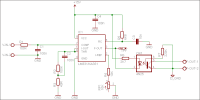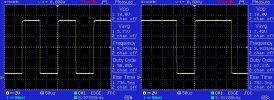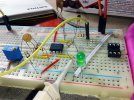The isolated analog input module presented here is particularly suitable for industrial electronics applications. Sending analog signals from field sensors over long-distance cables is often difficult because the signals can be influenced by unwanted noise from various sources and by ground potential differences within the loop. One proven method to avoid these cumbersome troubles is to provide a complete isolation from the field. My solution is a voltage-to-frequency (V-F) converter circuit with reliable galvanic isolation at its output. At the heart of the design is an inexpensive yet versatile V-F converter, the LM331 IC from Texas Instruments (www.ti.com).
Circuit description

Voltage-to-frequency converter module circuit
The circuit shown above is a basic voltage-to-frequency converter. It uses an LM331 (IC1) V-F converter and a 4N25 (OK1) optocoupler (www.vishay.com) as the galvanic isolator. With the power supply voltage set to 15 V, the input range is 0 to 10 V. Resistor R6 sets the drive current for 4N25, but it can be altered within the safe current limits of the 4N25 and the LM331. The waveform driving the output can be seen at point TPF. My design (tested with KA331) is, in fact, a mere adaptation of an application example found in the LM331 datasheet, published by TI. Refer to the LM331 official datasheet for more complex circuits with higher accuracy and/or faster response time. Note that the frequency goes from approximately 20 Hz at 0-V input to 10 kHz at 10-V input, and the duty cycle also changes as the input voltage changes (see random scope traces). The multiturn trimpot (RP1) should be set so that the duty cycle does not fling to 0% or 100% at the input extrema.
Next is the hardcopy of two random scope traces (just as a reference), caught while fiddling with my breadboard prototype (see the succeeding image). At first, the experiment was conducted with a green LED (with its current limiter resistor) in lieu of the optocoupler component, wired to observe what’s actually taking place there on that point.

Scope trace

Breadboard experiment
Application info
Circuit description

Voltage-to-frequency converter module circuit
The circuit shown above is a basic voltage-to-frequency converter. It uses an LM331 (IC1) V-F converter and a 4N25 (OK1) optocoupler (www.vishay.com) as the galvanic isolator. With the power supply voltage set to 15 V, the input range is 0 to 10 V. Resistor R6 sets the drive current for 4N25, but it can be altered within the safe current limits of the 4N25 and the LM331. The waveform driving the output can be seen at point TPF. My design (tested with KA331) is, in fact, a mere adaptation of an application example found in the LM331 datasheet, published by TI. Refer to the LM331 official datasheet for more complex circuits with higher accuracy and/or faster response time. Note that the frequency goes from approximately 20 Hz at 0-V input to 10 kHz at 10-V input, and the duty cycle also changes as the input voltage changes (see random scope traces). The multiturn trimpot (RP1) should be set so that the duty cycle does not fling to 0% or 100% at the input extrema.
Next is the hardcopy of two random scope traces (just as a reference), caught while fiddling with my breadboard prototype (see the succeeding image). At first, the experiment was conducted with a green LED (with its current limiter resistor) in lieu of the optocoupler component, wired to observe what’s actually taking place there on that point.

Scope trace

Breadboard experiment
Application info
- For improved performance, all of the components should be stable low-temperature-coefficient components, such as metal-film resistors and capacitors with low dielectric absorption.
- For an optional offset adjustment add-on circuit, refer to Page 12 of the official LM331 datasheet (SNOSBI2C — JUNE 1999 — REVISED SEPTEMBER 2015).
- For proper operation, the supply pin should be bypassed to ground with a 1-µF, low-ESR–type capacitor. The bypass capacitor must be placed as closely as possible to the supply pin.
- Use of a ground plane is highly recommended to provide a low-impedance ground across the circuit. Refer to Page 18 of the datasheet to learn more about PCB layout guidelines.
- You should need a stable lab power supply, a frequency counter, and an oscilloscope for testing/evaluating the circuit. Remember, a breadboard prototype is very sensitive to the electrical grid noise (50/60 Hz) in most situations.
- The optocoupled output of the V-F converter can be used as an analog input for a microcontroller (such as Arduino) for further treatment of the available signal.
